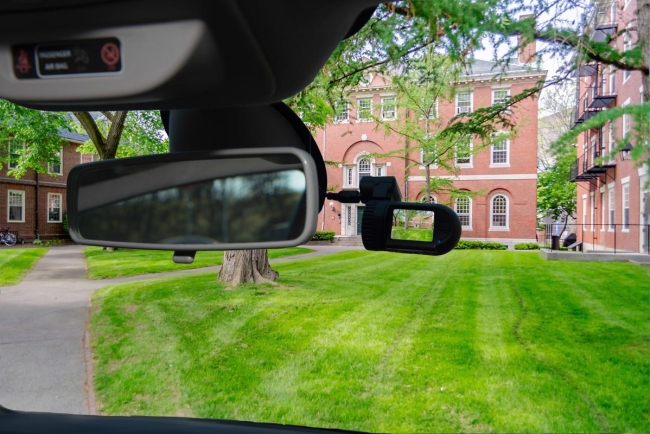You have /5 articles left.
Sign up for a free account or log in.

bwzenith/iStock/Getty Images Plus
A little over a year into the COVID-19 pandemic, high school senior Olivia Broderick got her acceptance from the University of Wisconsin at Madison and knew she’d need a campus visit to solidify that all-important college decision. While formal in-person tours were still on hold, she and her parents were on a plane from Boston, headed to Madison, within a week.
“The weather was bad. It was spring—it was raining; it was so gloomy. I loved it!” says Broderick, now a freshman at the institution, recalling her self-guided campus tour of the lakeside campus that has a city bordering another side. Her mom pointed out that liking the university on a bad-weather day was a sure sign of it being the right choice.
Today, official tours have resumed at Madison—except for residence hall interiors—and Broderick works for the admissions office leading them. “I get really excited and I always say I never had a tour of campus,” she notes.
Many students coming to campus for the first time “are just taking it all in,” Broderick says, comparing that to an admitted students’ day tour, where students tend to have “more specific questions, because they’re actually truly considering coming.”
On any tour, while walking between stops, Broderick will make a point of talking individually to different students, asking where they’re from and inviting questions. She estimates that 90 percent of questions come during such moments with the one-on-one feel. “That’s the main thing you don’t get with the virtual tours.”
The earliest iterations of virtual campus tours, and third-party provider options for development assistance, date back to the mid-1990s, but COVID-19 renewed the importance of being able to show off a college campus when a traditional tour is unavailable.
The latest Student Voice survey, which explored the admissions and enrollment process of current students, asked its 2,001 respondents about campus visits. Fifty-six percent of students whose college decisions took place during the pandemic still managed to take an in-person tour (with 12 percent of these students also taking a virtual tour). Other highlights of the survey, conducted Feb. 23 to March 1 by Inside Higher Ed and College Pulse, with support from Kaplan, include that:
- Three in 10 respondents who went through admissions during COVID did not take any type of campus tour; that’s the case for only about one in five students who were already in college when COVID hit.
- Eleven percent of students whose admissions were impacted by COVID took a virtual campus tour only, compared to 3 percent of students in college before March 2020.
- The percentage of students who took either type of tour and strongly agree that the tour accurately depicted campus life is about one in four—both for those already in college at COVID’s start and those who went through admissions during the pandemic.
[block:block=176]
While admissions officers and enrollment administrators will always encourage in-person visits, the survey results point to the need to continue strengthening in-person and virtual campus tours. Awareness of how students view campus tours, including how COVID closures impacted such experiences, can help determine where to invest resources and time.
Touring During COVID
When a virtual tour is the only option, prospective students may be more critical of that experience. One survey respondent at a public university in Texas, who couldn’t tour the institution in person during the pandemic, lamented that the virtual tour website was difficult to navigate. “I would need to go to 10 different pages, each saying variations on the same thing,” the student wrote.
But even in-person tours during the past two years left students with questions. “I wasn’t allowed to tour the dorm rooms, which made deciding which to stay in difficult,” wrote one residential community college student in Iowa. “I just didn’t have enough information to determine if the school was the best pick for me because I wasn’t allowed to see everything.”
At the University of Rochester and many other higher ed institutions, COVID prompted admissions teams to enhance virtual campus exploration experiences.
Rochester now gives its existing virtual campus tour a more immersive experience, using new footage captured once students had returned to campus during COVID, says Robert Alexander, dean of admissions, financial aid and enrollment management.
But families could visit in person even during the time when on-campus tours weren’t available. “When we were closed to visitors, we did enable, with QR codes and other messages, the ability for those walking campus to use a mobile-optimized virtual tour,” Alexander says. “More and more schools are doing that.”
Forty-four percent of students looking at colleges during COVID toured in person but not virtually, compared to 68 percent of those already in college in spring 2020. The biggest demographic standout on in-person tours involves first-generation students, who are less likely than others to have toured in person as well as more likely to not have taken any type of tour.
Impressions Made
The ultimate goal during COVID, says Fox Troilo of Hanover Research, has been finding safe ways to hold in-person tours. “It’s very powerful for a student to envision themselves at that institution. There’s something about creating that bond by literally having your feet in the grass or walking through a classroom and touching the seat.”
One survey respondent at a Long Island, N.Y., university noted, “The campus was very clean and upkept, including the landscaping, which I admired. I enjoyed seeing the water fountains and psychology buildings where I thought I would spend most of my time.”
Troilo, managing director of Hanover’s higher education research adviser team, saw that “some institutions floundered in trying to get virtual tours up and running.” Still, he adds, “a virtual tour is better than no tour. What is key about a tour is the personal nature of it. You lose something if you remove that component.” Troilo advises that colleges make their virtual tours feel as personal as possible.
One way Juniata College has helped replicate the in-person experience has been allowing prospective students to join one of about five daily scheduled “live guided virtual tours,” says Jason Moran, vice president for enrollment. During these events, a student tour guide literally walks through campus as virtual visitors follow along from home. The tactic “humanizes” that tour, he adds, allowing visitors to hear stories about each space.
Meanwhile, Moran’s department has been working with a third-party provider to ensure its virtual tour better represents the campus experience, and a new release is expected by June.
When Student Voice survey respondents were shown 26 potential factors that may have influenced their college choice, “look and feel of campus” emerged as the seventh-most-popular factor noted. Those who had taken an in-person tour were especially likely to have selected that item—50 percent—while fewer than one in five who had not taken any type of tour did so. With results filtered by race, white students were the only group to care more than the full survey sample about how their campus looked.
Virtual and Equitable
Ffiona Rees, chair of the board at the National Association for College Admission Counseling, explains that the draw toward virtual—in tours and other admissions events—is not just about COVID safety but also about equity. “Providing more online programming is a huge benefit to equity—it really opens the doors,” says Rees, who is also deputy director for undergraduate admission at the University of California, Los Angeles.
“Visiting campus is not just for those who can afford to visit campus,” she points out. Besides travel, the prospective student or parent needing to take time off from work is one cost.
And for those without their hearts set on a particular college, the costs multiply. Virtual admitted student events “can be a wonderful access point for students who don’t have the means to come in person and visit a large number of campuses with family members,” says Alexander.
In terms of virtual interaction, Alexander sees it grow during the course of an event, starting with students introducing themselves via the Zoom chat. “Once students feel safe and comfortable there, you see them unmute themselves and turn on the camera,” he says. Rochester’s online admissions events have run the gamut from being an intimate setting with 10 to 20 students up to a large attraction, with hundreds of students participating.
When touring virtually, some students do want to just get in and then quickly out. As one survey respondent wrote about the interactive video tour at a public university in the Pacific Northwest, “it didn’t take up a lot of time and I got to pick what I looked at.”
The survey asked students who had toured virtually about content and features, and the full sample was asked what virtual tours should include. A video tour, an interactive campus map and video of residence halls emerged as the top three responses for both questions. Virtual tours taken were much less likely to have included footage of dining halls or classrooms, but these stood out as top desires.
One write-in comment from a student at a Southern public university called for more interactivity and depth on the virtual tour. “I would also make sure the videos are updated and that the virtual experience is the same quality as an in-person tour would be,” the student wrote.
In reviewing the Student Voice data, Ken Anselment of Lawrence University noticed that students’ main virtual tour desires don’t necessarily call for investments in the latest technology. “They don’t want them more gamified or interactive; they want them more vibrant and exciting,” says Anselment, vice president for enrollment at Lawrence University and host of ALP: The Admissions Leadership Podcast. “It sounds like they’re hungry for better content on the tours.”
Authenticity and Specificity
Of the 1,687 Student Voice respondents who took an in-person and/or virtual campus tour of their college or university, about eight in 10 agree at least somewhat that it offered an accurate depiction of what it would like to be a student there. Students at private institutions and first-generation students, however, are less likely to agree.
Admissions teams should consider that transitioning to less restrictive COVID mitigation measures may mean the need for new images and footage. In other words, says Moran, “those mask pictures need changing.”
COVID or not, an ever-present challenge with any type of tour is managing to stand out compared to other institutions, says Alexander. “So much of college experiences within institutional levels and ranges are very similar. Our job on the college side is to articulate what is distinct and different about this experience versus our peers who on paper would seem very similar.”
An additional challenge in showing what makes a place special arises in virtual tours developed by third-party providers. “You want to make sure you’re distilling the essence of your institution, making sure your institutional voice comes through,” says Anselment. Colleges may not have the resources to create their own virtual tours, he adds, but they “do have that ability to shape them.”
Admissions teams also have the ability to use applicants’ social media postings to help in making decisions, and 34 percent of Student Voice respondents believe it’s very (9 percent) or somewhat (25 percent) true that this is actually happening. That’s just a bit higher than reality, at least according to Kaplan’s 2021 college admissions officers survey, which found 27 percent of these professionals will visit social media profiles to learn more about students.
The flip side is more common, particularly during COVID, with students checking in on institutions’ feeds. For students who can’t tour, such content might be scrutinized.
“I looked at all the social places for my universities,” says Broderick, referring to the nine institutions where she applied. Although she recognizes that every university will post its best face, she was looking mainly for a sense of the campus vibe since she couldn’t visit before applying. Her mind-set involved seeing “what’s going on and what it looks like on an average day of classes,” she explains.
Troilo from Hanover Research has noticed a growing trend of prospective students checking institutional profiles as part of the college choice process and looking for “that strong positive network,” he says (as well as the opportunity to connect immediately with peers). “It speaks to relevancy in terms of relatability. You don’t want to go someplace where it seems like they’re out of touch.”
The virtual tour connection, says Alexander, is how the experience “bleeds over into the YouTube and social media presence to showcase what life is like” on campus. Its purpose, to a student, is not about wayfinding but rather about answering this question: What would my life be like here?
Read more analysis of results from the Student Voice Outlook on Admissions survey, including a look at what went into students’ college decisions and what changes they’d like to see in admissions process.








